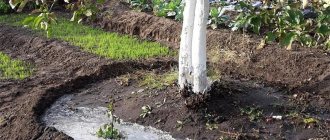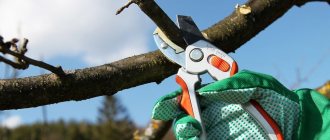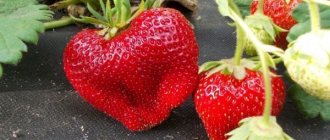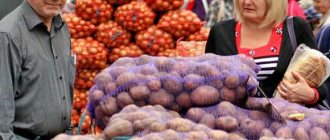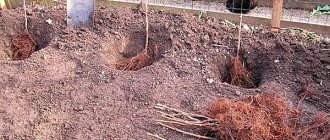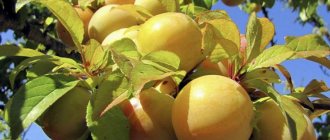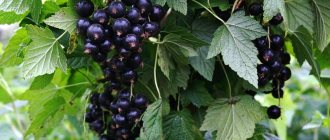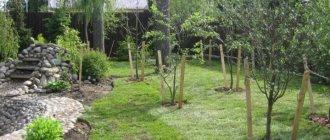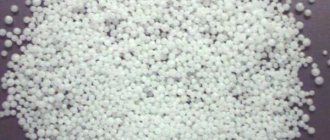The most productive varieties: Apple trees
Jonathan (up to 490 kg), Orlovskoe striped (270–430 kg), Wellsie (up to 275 kg), Anis striped (gray) (250–300 kg), Ural bulk (250 kg), Kuban Cossack (250–300 kg) , Scarlet anise (200–300 kg), Winter MOSVIR (200–300 kg), Renet golden Kursk (200 kg), Yandykovskoe (200 kg), Borovinka (150–200 kg), Luch (160–190 kg), Dagestanskoe winter (up to 180 kg), Baganenok (156 kg), Orlovsky pioneer (up to 150 kg), Malt Bagaevsky (160 kg), Autumn joy (up to 150 kg), Nymph (130 kg), Firstborn Rtishchev a (130 kg), Prizemennye (130 kg), Prikubanskoe (130 kg), Renet Kubansky (130 kg), Sovkhoznoe (130 kg), Idared (95–130 kg), Renet Simirenko (80–130 kg), Bratchud (120 kg), Orlik ( up to 120 kg), Bryanskoe (110 kg), Martovskoe (110 kg).
For comparison: the popular Antonovka vulgaris yields approximately 70–90 kg per tree, and many other varieties produce even less – 30–50 kg.
The most productive varieties: Pears
Most pears produce an average of 30–50 kg per tree. But there are real “Stakhanovites” from whom you can get a harvest of 3, or even 10 times more!
Kieffer (up to 300 kg), Ruddy Berkut (up to 250 kg), Tonkovetka (250 kg), Bere Russian (up to 200 kg), Cosmic (up to 150 kg), Dessert Rossoshanskaya (up to 140 kg), Augustinka (130 kg), Marble (up to 130 kg), Talitsa (125 kg), Nalchik Kostyka (120–130 kg), Lyubina (120 kg), Oktyabrskaya (120 kg), Nart (100–170 kg), Astrakhan rannyaya (100-150 kg) , Skoroplodnaya (100–130 kg), Early (100-120 kg), Yuryevskaya (110 kg), Bere Dil (100 kg), Malyaevskaya late (100 kg), Record holder (100 kg), Morning freshness (100 kg), Chernomyaska gullet (100 kg).
INTERESTING FACT about pears
The Gimrinskaya variety has an average yield of 110 kg. But individual trees, with good care, can produce from 800 to 3,500 kg! Just imagine, a whole dump truck of pears from one tree!
Useful and harmful proximity of fruit trees and shrubs in a garden plot
Knowledge of the needs of individual plant species and their characteristics is of considerable importance for the future of planting:
- Some crops prefer to grow in the sun, while others easily adapt to the shade.
- For some fruit trees and shrubs in the garden plot, an open, windswept place is suitable, while for others you will have to find shelter.
- Plant requirements for fertility and watering vary.
It is unlikely that in a limited area of land it will be possible to satisfy all the needs of green pets. In a small country garden, inevitably some shrubs end up under the canopy of growing trees. To ensure that such proximity does not affect the yield, the location for planting shade-loving fruit trees and shrubs in the garden is determined in advance.
Such crops include black currants, honeysuckle, low-growing berry bushes, such as cranberries, blueberries and lingonberries. If the shady corner of the garden is well ventilated, viburnum will thrive here. Blackberries and raspberries are grown in partial shade.
Gardeners have long noticed that even in comfortable conditions, garden plants sometimes refuse to bear fruit at full strength, look depressed and grow poorly. It turns out that the reason for this behavior is an incorrectly chosen neighborhood. As in nature, in an orchard, trees, shrubs and herbaceous crops form close communities. The given options for successful and dangerous neighborhoods of fruit trees and shrubs in the table will help create the best conditions for each species and get the maximum benefit from it.
You can arrange the plantings so that closely related plants are nearby. This solution will be extremely useful, for example, for cherries and petioles, many varieties of which are self-sterile and require a pollinator to produce a harvest. A similar picture is observed when growing sea buckthorn. True, here there must be one male bush for several female plants.
In addition, for sea buckthorn, which readily reproduces by root cuttings, blackberries and raspberries, it is better to find a place away from the rest of the garden plantings, otherwise the powerful shoots of these crops will take over half the garden within a year.
The most productive varieties: Plums
Volgogradskaya (150 kg), Mechta (70 kg), Nika (up to 70 kg), Zhiguli (up to 70 kg), Krasnodarskaya (65 kg), Prikubanskaya (60–70 kg), Viola (up to 60 kg), Renklod Soviet ( up to 60 kg), Eurasia 21 (50–100 kg), Bogatyrskaya (50–70 kg), Andreevskaya (50–55 kg).
For most other varieties, the yield does not exceed 15–20 kg.
The most productive varieties: Apricots
Southern varieties of apricots produce enviable yields - 70–80, and some even 100 kg per tree. Northern, frost-resistant varieties cannot boast of such records - on average, they can produce about 20 kg of fruit. And yet there are varieties that, although they do not reach their southern counterparts, are at least 2 times superior to the northern average ones.
Northern Triumph (up to 64 kg), Kuibyshev Jubilee (40–50 kg), Samara (40–50), Northern Lights (up to 47 kg), Zhemchuzhina Zhiguli (up to 46 kg), Gritikaz (up to 45 kg), Petr Komarov (up to 45 kg), Sayan (up to 45 kg), Mountain Abakan (up to 41 kg).
Video
This video will tell you about the rules for planning a garden plot.
To create the perfect garden, it is not at all necessary to call a landscape designer. By following simple rules for the comfortable arrangement of garden crops, and focusing on the lighting preferences of plants, you can easily plan the site yourself. For clarity, it is advisable to use a paper seating plan, on which you must first mark all the buildings and general nuances of the area. Simple techniques and basic information about the possible location of popular crops are given in our article. A list of the best varieties of repair raspberries is presented at the provided link.
The most productive varieties: Cherries
The average yield for most cherries is 10 kg per tree. If you manage to collect 16–20 kg, this is pure happiness! But there are varieties that produce fruits 3 or even 7 times higher than usual!
Toy (up to 72 kg), Griot Ostheim (60–90 kg), Garland (up to 60 kg), Lada (up to 60 kg), Nadezhda (up to 60 kg), Lyubskaya (up to 50 kg), Kent (up to 40 kg) , Zhukovskaya (up to 30 kg), Griot Melitopol (up to 30 kg).
Types of garden: choose according to your capabilities
Now you need to decide what kind of garden you need: fruit and berry, ornamental or mixed. First of all, you need to consider how much time the gardener can devote to caring for the garden.
The least amount of time will be spent caring for wild trees in a park-type garden—maple, birch, and regular or blue spruce trees grow there. Care will be reduced to pruning trees in spring or autumn, whitewashing trunks, spraying against possible pests and mowing grass between rows. You can add rowan, viburnum, lilac, and bird cherry to such a garden. They add bright colors to the garden, but are also unpretentious.
The most common type of garden is mixed, in which fruit and berry crops and ornamental crops grow. Such a garden will have to pay more attention. In mixed gardens, ornamental crops are usually planted next to buildings: a house, a veranda, a gazebo, and they are lined with ponds. Fruit trees for the garden are planted separately.
The gardener will spend most of his time caring for the fruit and berry garden. For successful fruiting, each crop requires a whole range of measures for feeding, pruning and shaping, protection from pests and frost. In this case, the gardener will have to study a lot of information. Advanced gardeners independently graft trees.
The most productive varieties: Sweet cherries
Southern varieties of cherries produce an average of 100 kg of fruit per tree. Cold-resistant ones are much more modest - they can ripen 20, at most 30 kg. But there are northern cherries that are significantly superior to their average sisters. And some varieties will give a head start even to the southern ones!
Black Daibera (up to 170 kg), Bryanochka (up to 150 kg), Tyutchevka (up to 138 kg), Yellow Drogana (up to 110 kg), Odrinka (up to 110 kg), Yulia (up to 110 kg), Gronkavaya (100 kg), Ovstuzhenka (up to 100 kg), Rechitsa (up to 73 kg), Iput (up to 70 kg), Early pink (up to 70 kg), Pink pearl (up to 70 kg), Malysh (up to 63 kg), Aprilka (60 kg), Lena (up to 60 kg).
Growing and care
A caring owner knows that the more attention he pays to the plantings, the better they will grow and bear fruit. Plant care must be competent and timely. General rules for caring for fruit trees:
- In spring, remove old, diseased and frost-damaged branches. The procedure is carried out in early spring, before sap flow begins. After pruning, the branches are disinfected with copper sulfate and treated with garden varnish. The same applies to trees damaged by rodents. As soon as the buds begin to appear on the bushes, they must be whitened and sprayed with a disinfectant solution against pests (purchased at the store depending on the type of garden crop).
- In summer, it is necessary to water the bushes in a timely manner during the period when there is no rain. Foliar feeding with microelements is carried out with the obligatory application of nitrogen. If pests appear on the leaves, you must remove them manually. If there is a large concentration of insects, the bushes are treated with insecticides. The only condition: processing should be completed before fruit set. After harvesting, it is necessary to clear the tree trunk circle of fallen leaves and fruit residues. There should be no debris or rot near the tree, this will avoid various diseases.
- In the fall, another fertilizing is applied with complex fertilizers (without nitrogen). The trees should then be whitewashed to kill insects hidden in the bark. The trunks of heat-loving crops (cherries, pears) must be wrapped with roofing felt or covered with sheets of roofing felt. You can lay burlap between the insulation and the trunk. This will effectively protect the trunk from frost. In areas with strong winds, it is recommended to cover the tree trunk circle with snow and compact it. This will save the root system from freezing.
Every garden owner can create a garden that will provide a generous harvest. It is necessary to take the issue of planting and caring for trees seriously. The intensity of growth and fruiting depends on this.
The most productive varieties: Sea buckthorn
It so happened historically that all varieties of sea buckthorn can be divided into 3 groups. From low-yielding plants, you can collect 5–6 kg per bush. Fortunately, there are few of them. The average ones (the majority of them) give 10–12 kg. And at the most fruitful ones, more than 15 kg of berries ripen!
Moskvichka (21 kg), Botanicheskaya (up to 20 kg), Moscow pineapple (18.8 kg), Panteleevskaya (up to 17.6 kg), Minusa (17.4 kg), Chechek (16.8), Inya (16, 2 kg), Nivelena (16.1 kg), Sayana (up to 16 kg), Ruet (15.8 kg), Tenga (15.6 kg), Pepper Hybrid (15.2 kg), Moscow Beauty (15 kg) , Otradnaya (15 kg), Botanical amateur (up to 15 kg).
Columnar trees
For those on whose site it is problematic to place at least a few spreading plants, we can recommend columnar trees. They got their name because of the external similarity of their shape to a column. From a distance, it seems that these plants have no branches at all. This is not so - there are branches, but they are short.
Columnar apple tree
Features and Disadvantages
Columnar trees have their own characteristics and disadvantages associated with their external characteristics.
Advantages:
- Compactness. Such plants do not require a large area;
- Productivity. Trees become fruitful already in the 2nd year of life;
- Unpretentiousness. No special conditions are required for them;
- Decorative. Young trees serve as decoration for the site.
Columnar trees have only two disadvantages: fragility (they bear fruit for no more than 20 years) and higher cost than ordinary seedlings.
How to plant columnar trees
Columnar trees love loose, rich, sandy loam soil and sunlight. They do not tolerate stagnant moisture at the roots and drafts.
Seedlings are planted in spring, at a distance of 1 m from each other. If there are several seedlings, their planting pattern is square, with sides of 1 m. To do this, dig a hole 60x70 cm in advance. When the soil settles, you can lay drainage on the bottom, add a spoonful of nitrogen and potassium fertilizers, and sprinkle a little soil.
Having straightened the roots, place the seedling in the hole and cover it with soil up to the root collar, gently compacting it with your hands. Afterwards, all that remains is to water the planting generously.
How to care
Rules for caring for columnar fruit trees:
- Watering. Young trees are watered once a week in dry summers or less often if it rains frequently. Sprinkling in hot weather is also beneficial for them;
- Feeding. 1st application on melted snow (nitrogenous), 2nd - during the flowering period (mullein solution) and the same composition is applied again a week after flowering. The 4th application is carried out in the fall (phosphorus and potassium);
- Trimming. This procedure is performed extremely rarely if long side shoots appear. It is important not to forget to lubricate all cut areas with garden varnish.
Garden with fruit and berry plants
The variety of garden trees allows you to choose the best options for your site. Finding fruit and berry bushes that will delight you with a harvest every year is also easy. You can safely plant the garden of your dreams.
The most productive varieties: Black currant
The average yield for most blackcurrant varieties is 1.5–2 kg per bush. But there are record holders who produce 2–3, or even 7 times more berries!
Ksyusha (up to 13.8 kg), Nyura (up to 7 kg), Podarok Ilina (up to 6.6 kg), Imandra 2 (6 kg), Harmony (up to 6 kg), Kupalinka (up to 6 kg), Lama (up to 5.9 kg), Sudarushka (up to 5.9 kg), Pygmy (up to 5.7 kg), Hera (up to 5.5 kg), Natasha (up to 5.2 kg), Venus (up to 5.1 kg) , Reforma (up to 5.1 kg), Amgun (4-4.5 kg), Leningrad Giant (up to 4.5 kg), Nika (up to 4.5 kg), Pamyati Shukshin (up to 4.5 kg), Rita (up to 4.5 kg), Dashkovskaya (up to 4.1 kg), Little Prince (up to 4.1 kg), In Memory of Potapenko (up to 4.1 kg), Daughter (4 kg), Moscow (4 kg), Argazinskaya (up to 4 kg), Volodinka (up to 4 kg), Odzhebin (up to 4 kg), Gift to Kuzior (up to 4 kg), Gift to October (up to 4 kg), Sweet-fruited (up to 4 kg), Overture (up to 4 kg).
The most productive varieties: Gooseberry
On average, one gooseberry bush produces 2–4 kg of berries. But you can collect many times more if you plant:
Hinnonmaen punainen (up to 13 kg), Beryl (up to 10 kg), Ural pink (up to 9.6 kg), Bright (up to 7.8 kg), Shershnevsky (up to 7.6 kg), Vladil (up to 7.5 kg ), Spring (up to 7.5 kg), Chelyabinsk green (up to 7.1 kg), Eridan (up to 7.1 kg), Ural grapes (up to 7 kg), Cooperator (up to 6.9 kg), Red large ( up to 6.5 kg), White Nights (up to 6.2 kg), Candy (up to 6.2 kg), Harlequin (up to 6 kg), Senator (up to 6 kg).
The most productive varieties: Raspberry
For most raspberry varieties, the average yield fluctuates around 50 kg per hundred square meters. For example, the popular Kuzmin News gives 50–70 kg. And if you want more, plant these varieties:
Nizhny Novgorod (183 kg), Ruby Necklace (158 kg), Orange Miracle (155 kg), Elegant (140 kg), Eurasia (134 kg), Bryansk Miracle (131 kg), Firebird (131 kg), Illusion (130 kg), Vera (up to 129 kg), Golden Autumn (126 kg), Bell (up to 120 kg), Ruby (up to 120 kg), Apricot (100-120 kg), Augustine (117 kg), Indian Summer 2 (115 kg).
